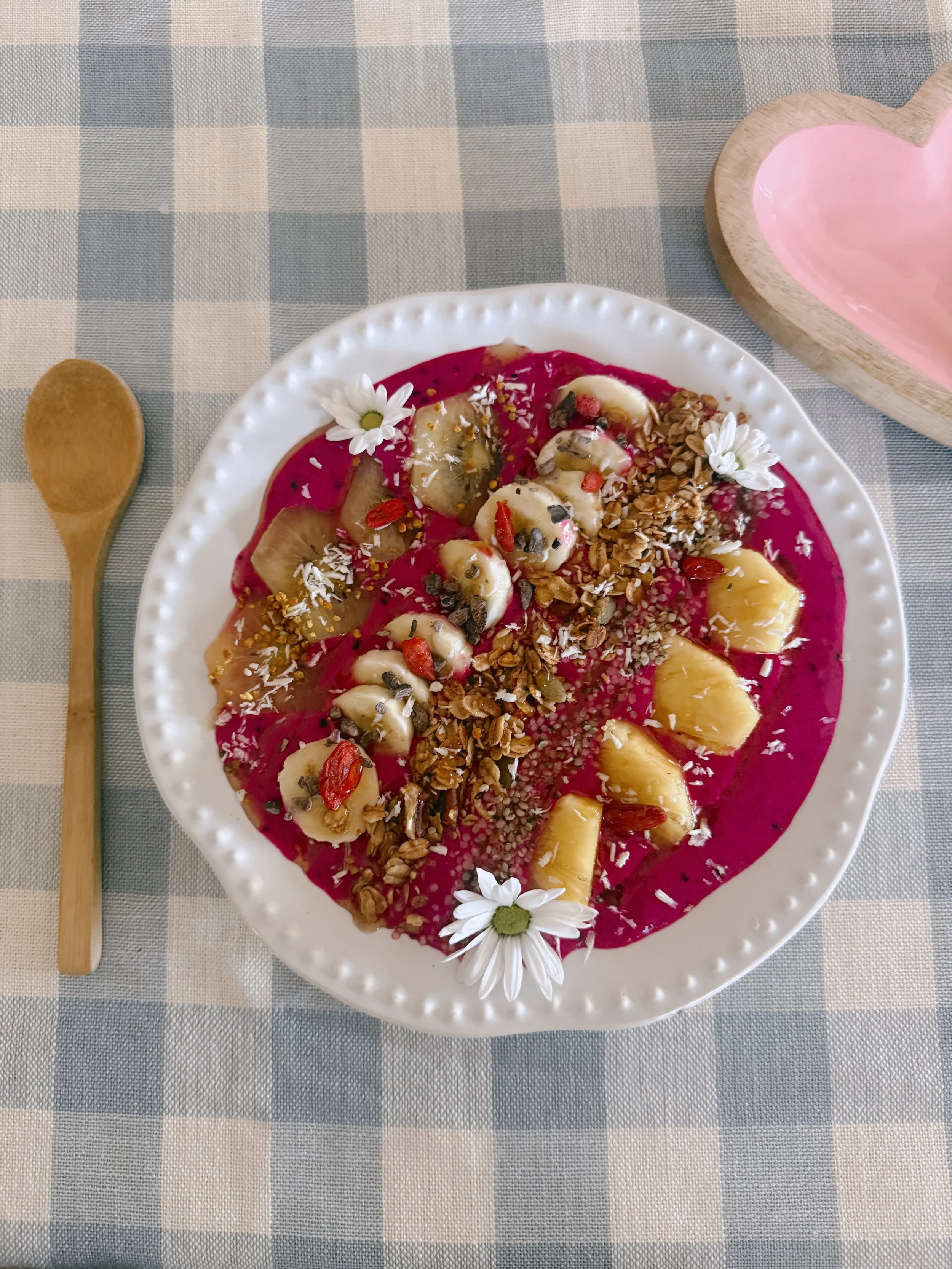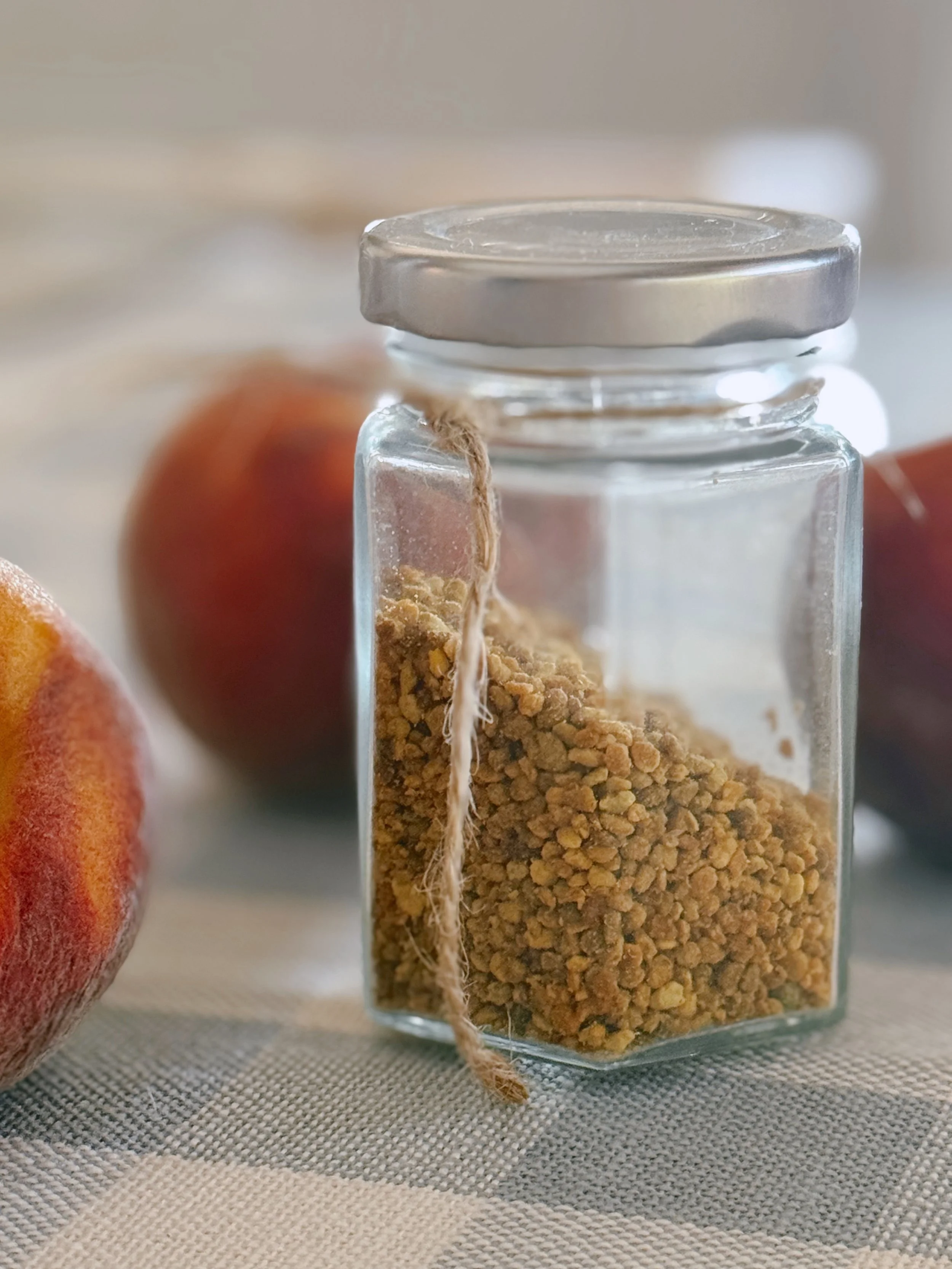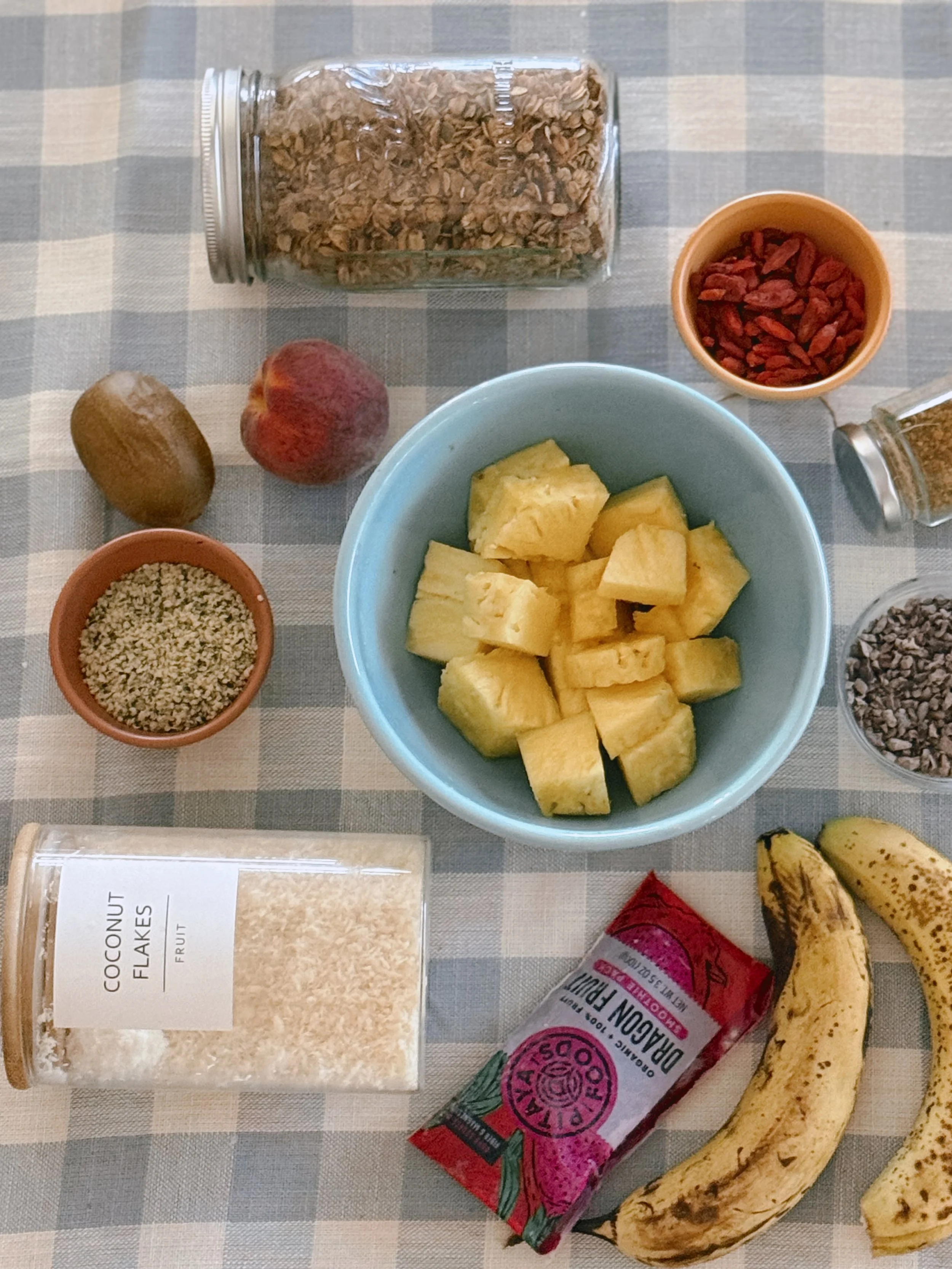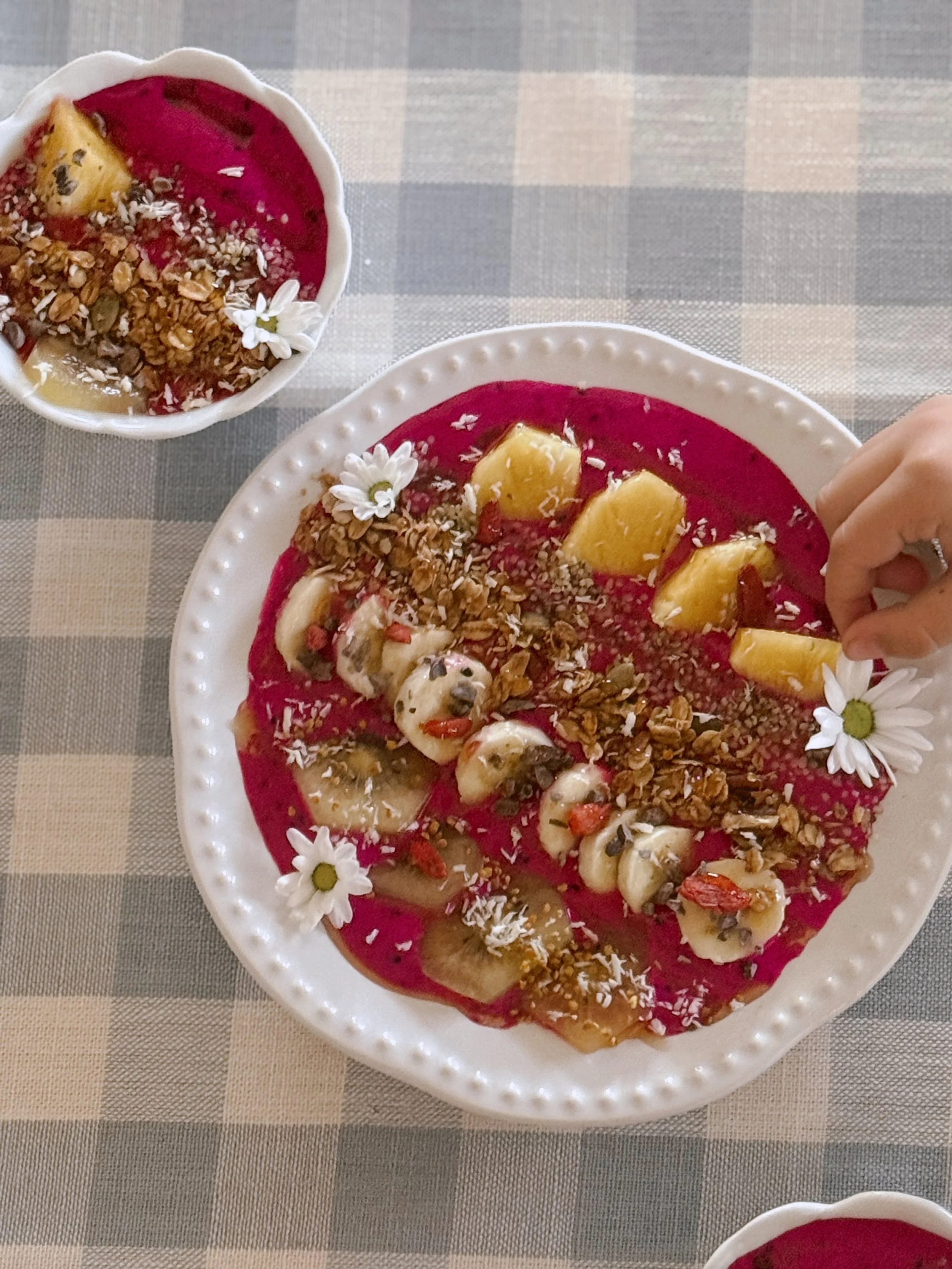Pitaya Bowls: A Refreshing, Nutrient-Dense Treat
By: Courtney G. Clifford
On a hot day, there’s nothing quite like a vibrant pitaya bowl: smooth, sweet, and bursting with wholesome flavor. These beautiful bowls are a delightful canvas—perfect for kids to customize and fun for the whole family.
The Base Recipe (Serves 3)
1 cup frozen dragon fruit (pitaya)
2–3 ripe bananas
½ cup frozen strawberries
4 oz coconut water or apple juice
Blend everything for about 45 seconds until smooth, then pour into bowls and top to taste.
Fun & Nutritious Add-Ons
Shredded coconut flakes
Cacao nibs
Goji berries
Pineapple
Golden kiwi
Raw honey
Local bee pollen
Homemade granola
Hemp hearts
Feel free to swap in any fruit or topping you have—berries, mango, nuts, seeds… no limits!
gathering ingredients and “sprinkles”
Why Pitaya Bowls Are Nutrient-Rich & Delicious
1. High in Fiber & Supports Digestion
Dragon fruit is a prebiotic powerhouse, thanks to its oligosaccharides and dietary fiber. These naturally support digestive health by feeding beneficial gut bacteria, which can also contribute to stronger immune function. One cup of pitaya provides roughly 5–7 grams of fiber, which is a significant part of the recommended daily intake of 25–35 grams.
2. Loaded With Antioxidants for Cellular Defense
Pitaya is rich in antioxidants like betacyanins, carotenoids, polyphenols, and vitamin C. These compounds play a key role in reducing inflammation, neutralizing free radicals, and supporting heart health and cellular repair. Betacyanins, the pigment that gives red pitaya its vibrant hue, have also been studied for their potential anticancer properties.
3. Vitamins & Minerals for Strength & Immunity
Pitaya is a source of several essential micronutrients:
Vitamin C: supports immune defense, iron absorption, and collagen production
Magnesium: promotes healthy nerve and muscle function
Iron: necessary for energy and oxygen transport
Potassium and calcium: help maintain bone strength and heart function
Together, these nutrients help the body recover, rebuild, and thrive.
4. Supports Heart & Metabolic Health
Dragon fruit’s fiber content and antioxidant profile contribute to improved lipid profiles and enhanced insulin sensitivity. Some animal and human studies suggest that regular consumption of pitaya may help manage blood glucose levels and reduce cholesterol, supporting heart and metabolic wellness.
5. Calorie-Light, Nutrient-Heavy
A typical serving of pitaya contains around 60–120 calories, depending on how it's prepared. It's a great choice for those seeking nutrient-dense options that don’t compromise flavor or satisfaction.
6. Promotes Gut & Immune Health
Pitaya’s prebiotic compounds fuel beneficial gut bacteria like Lactobacillus and Bifidobacterium. A healthier gut microbiome strengthens the immune system and supports mood, energy, and cognitive clarity—foundational for whole-body health.
The Perfect Family-Friendly Treat
So, why do pitaya bowls feel like a mini celebration in a bowl—especially for families?
Interactive fun – Kids love getting hands-on with toppings, which makes healthy eating more enjoyable.
Cool and refreshing – The icy-smooth texture is perfect on hot days or after active play.
Nutrient-dense – Every bite delivers a dose of vitamins, minerals, antioxidants, and fiber.
They’re also great for breakfast, post-exercise fuel, or a satisfying afternoon snack.
Your Ideal Pitaya Bowl: Step-by-Step
Blend the base
Combine 1 cup frozen pitaya, 2–3 ripe bananas, ½ cup frozen strawberries, and 4 oz coconut water or apple juice. Blend until smooth and creamy (about 45 seconds).Divide and pour
Spoon the smoothie mixture into bowls for serving—this recipe makes about 3 servings.Top with your favorites
Sprinkle on shredded coconut flakes, cacao nibs, goji berries, pineapple, golden kiwi, raw honey, local bee pollen, granola, hemp hearts—or whatever fruit, seeds, or nuts you have on hand.Serve immediately
Enjoy while it’s cold and refreshing. Bonus tip: freeze leftovers into popsicle molds for a quick and healthy frozen treat later!
The Science Behind the Magic
1. Prebiotics + Fiber = Digestive Health
Dragon fruit is especially rich in soluble fiber and prebiotics. These compounds encourage the growth of healthy gut flora, which has been linked to better digestion, immunity, and even improved mood.
2. Antioxidants Reduce Oxidative Stress
Pitaya is one of the few fruits that naturally contains betacyanins, a group of antioxidants that combat oxidative damage and may help protect against chronic diseases. Antioxidants also help preserve youthful skin, support eye health, and assist the body in detoxifying naturally.
3. Heart and Blood Sugar Support
Studies have suggested that the fiber and phytonutrients in pitaya may help regulate cholesterol levels and improve blood sugar control, which is especially helpful for those managing metabolic conditions or seeking to support long-term cardiovascular health.
Benefits of Your Other Ingredients
Bananas: Provide potassium for hydration, natural energy, and gut-soothing pectin
Strawberries: Offer vitamin C, manganese, and plant compounds that reduce inflammation
Coconut water: Rehydrates with electrolytes like potassium and magnesium
Apple juice (if used): Adds a touch of sweetness and vitamin C
Together, these ingredients complement pitaya beautifully to make a refreshing, energizing, and healing meal or snack.
At-A-Glance Health Benefits
Here’s a quick overview of why pitaya bowls are such a nourishing choice:
Digestive Health
Thanks to the fiber and natural prebiotics in dragon fruit, these bowls support a healthy gut microbiome and smoother digestion.Immune Support
With a boost of vitamin C and gut-enhancing ingredients, pitaya bowls help strengthen your immune system.Antioxidant Protection
Rich in antioxidants like betacyanins and vitamin C, they help combat free radicals and reduce inflammation.Cardiovascular Health
The fiber content supports healthy cholesterol levels, while antioxidants promote strong, flexible blood vessels.Energy & Hydration
Natural fruit sugars offer quick energy, while coconut water helps replenish electrolytes—especially refreshing on warm days.Weight-Friendly Nourishment
Low in calories but high in nutrients, pitaya bowls are satisfying without being heavy, making them ideal for balanced eating.
Making It Fun for Kids
Pitaya bowls are a wonderful way to involve kids in the kitchen and spark their creativity:
Colorful toppings make the bowl look like a rainbow.
Sensory exploration—the soft base and crunchy toppings engage different textures.
Healthy choices feel like treats—especially when paired with honey, granola, and fruit.
A conversation starter—talk about where the ingredients come from, or how food can help their bodies grow strong and feel good.
Let them build their own “mini masterpieces” and they’ll eat every bite.
Keep It Fresh, Simple, and Flexible
There’s no one right way to build a pitaya bowl. The real magic comes from what you make of it. Whether you have pantry staples or a fridge full of fresh fruit, this base adapts to what you’ve got on hand.
Tips:
Use red-fleshed dragon fruit for deeper color and antioxidant content.
Add a scoop of Greek yogurt or nut butter for more protein.
Blend with frozen mango or pineapple to mix up the tropical flavors.
Final Thoughts
Pitaya bowls are one of those rare recipes that deliver big on both nutrition and joy. They’re loaded with health-promoting benefits—fiber, antioxidants, vitamins, minerals—while also being fun to make, naturally beautiful, and endlessly customizable.
If you’re looking for a refreshing way to nourish your body (and your family’s), these bowls are a go-to. From hot summer mornings to post-park afternoons, they’re a crowd-pleasing staple you’ll reach for again and again.
Start with the base, invite your kids to the kitchen, and enjoy the creative process—every sprinkle and swirl!
References
Eldridge, A. M., & Seitz, A. (2024). 7 health benefits and nutrition facts about dragon fruit. EatingWell.
King's, R. D. N. (2025). Should you eat yellow dragon fruit to help you poop? Verywell Health.
Tran, H. T., Le, T. N., & Nguyen, D. M. (2021). Biochemical and nutritional characterization of dragon fruit (Hylocereus spp.). Journal of Food Composition and Analysis, 103, 104112.
Neelwarne, B. (Ed.). (2012). Red beet biotechnology: Food and pharmaceutical applications. Springer.
Noor, N. M., & Aziz, M. N. (2020). Dragon fruit extract as a potential natural source of prebiotics and antioxidants. International Journal of Food Sciences and Nutrition, 71(2), 245–254.








